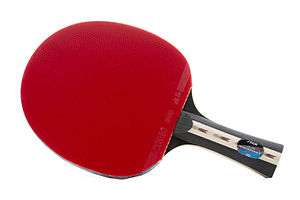Table tennis racket
A basic table tennis paddle (also known as a "Racket" or "bat") is used by table tennis players. The table tennis paddle is usually made from laminated wood covered with rubber on one or two sides depending on the player's grip. Unlike a conventional "paddle", it does not include strings strung across an open frame. The USA generally uses the term "paddle" while Europeans and Asians use the term "bat" and the official ITTF term is "racket".[1]

Rubber variations


Table tennis regulations approved by the International Table Tennis Federation (ITTF) allow different surfaces on each side of the paddle for various amounts of spin (including nullifying it) or speed.[2] For example, a player may have a spin-heavy rubber on one side of his paddle, and no spin on the other side. The player can flip the racket in play for different types of returns. To help a player distinguish between different types of rubber used by his opponent, regulations specify that one side of a paddle must be red while the other must be black, allowing a player to see what side of a paddle hits the ball mid-play. The player has the right to inspect his opponent's racket before a match to see the type and color. Current rules state that, unless damaged in play, the paddle cannot be exchanged for another at any time during a match.[3]
The rubber coating may be of pimpled rubber, with the pimples outward, or it may be composed of a sponge layer, covered by rubber that may have the pimples pointed inwards or outwards. Some paddles are not covered with rubber ("naked") to make it spin resistant. However, it is illegal to use these types of racket in competition as they are not approved by the ITTF. Some types of rubbers are also not approved. Approved rubbers have the ITTF emblem on the base of the rubber.[4]
Assembling
- Choices
Players have many options and variations in rubber sheets on their racket. Although a racket may be purchased assembled with rubber by the manufacturer, most serious tournament players will use a custom racket. A player selects a blank blade (i.e., a racket without rubber) based on his or her playing style. The type of wood or synthetic layers used to make up the blade will determine the blade's speed. The different types of rubber sheets affect the level of spin, speed, and other specific playing characteristics. Racket construction and new rubber technology contribute significantly to the amount of deviation from the expected ball flight path.
Glue and gluing
Normally, a sheet of rubber is glued to a blade using various table tennis brand glues such as Butterfly, Donic, and DHS. Some glues may work even if it wasn't designed specifically for table tennis, such as Rubber Cement and Tear Mender. The rubber is not removed until it wears out or becomes damaged. In the 1980s, some players developed a new technique with a special glue called speed glue to apply the rubber every time they played. The glue would help provide more spin and speed by providing a "catapult" effect.
The fairly recent development of speed glue speeds up the departure of the ball from the rubber considerably, though at the cost of some ball control on touch shots where little or no spin is put on the ball. Speed glue was allowed for the last time in the 2008 Summer Olympics. From the 2012 Summer Olympics onward, the Olympic games banned speed glue.[5]
Maintaining and protection
The surface of a racket will develop a smooth glossy patina with use. The rubber surface needs regular cleaning to retain a high friction surface for ball spin. Commercial cleaners or water and soap can be cleaning agents.[6]
Sun exposure may damage the rubber.
See also
References
| Wikimedia Commons has media related to Table tennis bats. |
- ITTF (August 2018). The International Table Tennis Federation Handbook 2019 (PDF). Retrieved 31 May 2019.
- Varenberg, M.; Varenberg, A. (2012). "Table tennis rubber: Tribologicaly characterization". Tribology Letters. 47 (1): 51–56. doi:10.1007/s11249-012-9961-4.
- "Ping Pong Paddle". Bestreviewshunt.com. 11 October 2016. Retrieved 17 November 2016.
- "Table tennis". www.sizes.com. Retrieved 17 November 2016.
- ITTF Bans Speed Glue, Boosters and Tuners - and Much More! Archived 2015-04-02 at the Wayback Machine By Greg Letts, About.com. Accessed September 2008
- "Table Tennis Information - Equipment maintenance". Megaspin. Retrieved 2007-07-10.